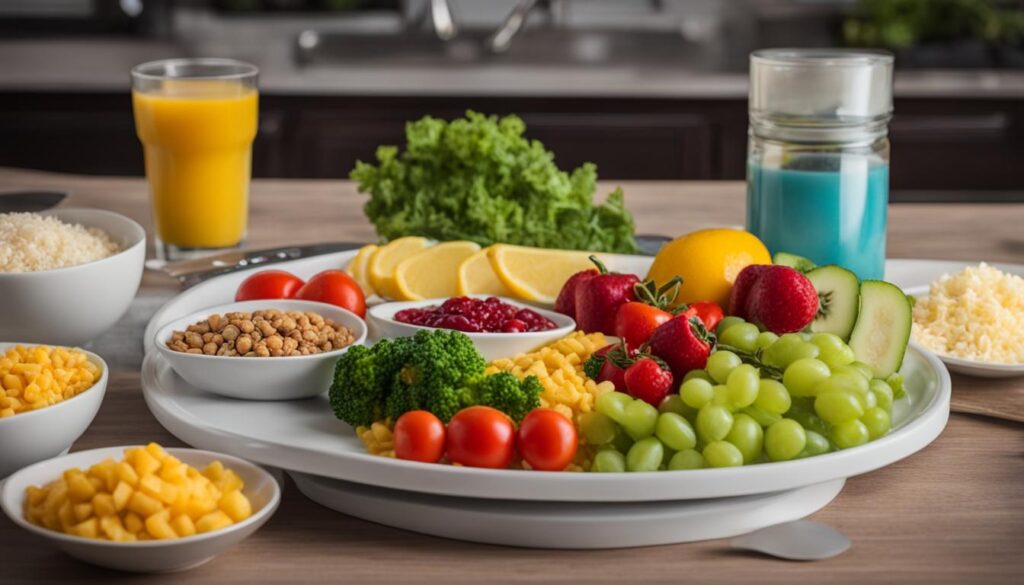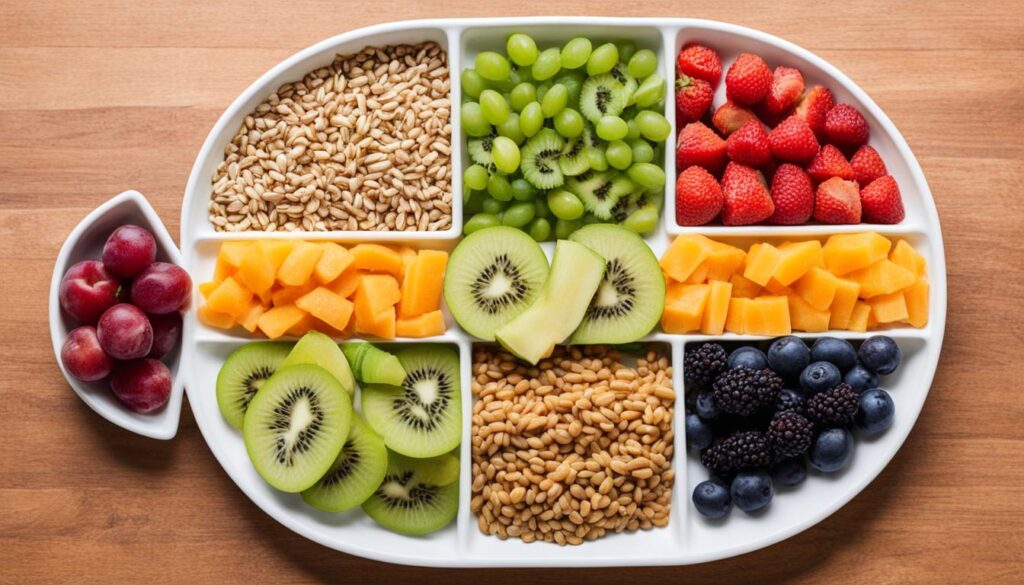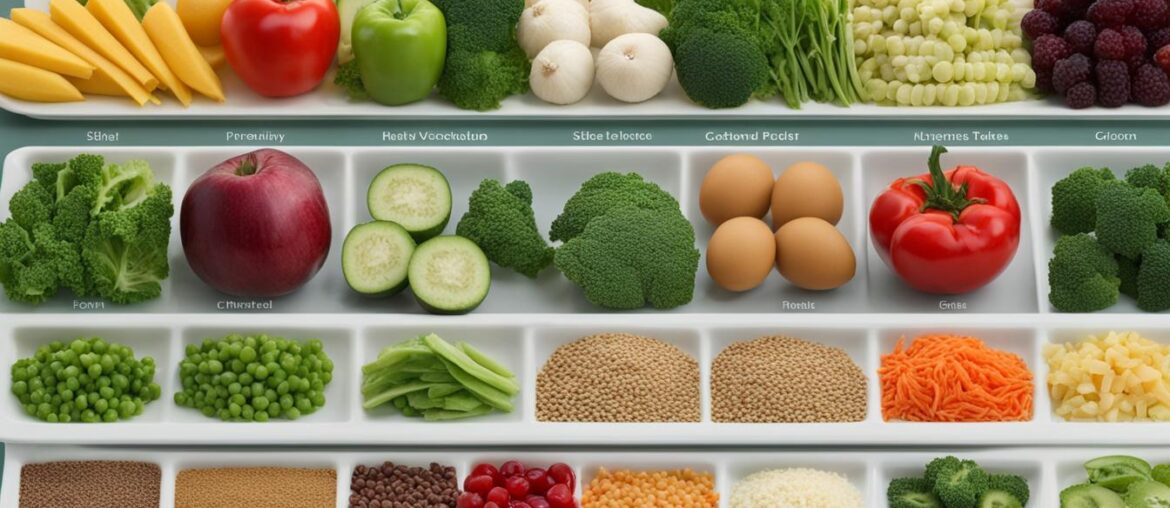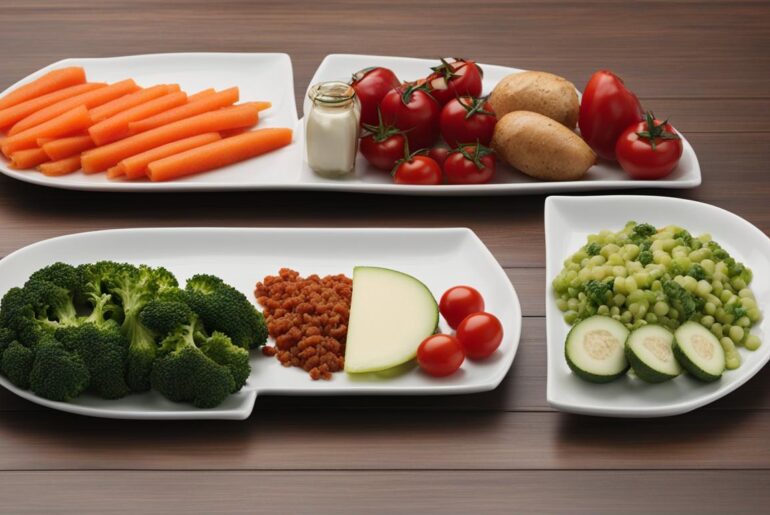Welcome to my comprehensive guide on mastering portion control for different food groups. In today’s world of supersized portions and calorie-dense meals, understanding the importance of portion control is crucial for maintaining a healthy diet and managing weight effectively. By learning portion control strategies and implementing them in your daily life, you can achieve a balanced diet, support weight loss goals, and develop a healthier relationship with food (check this post out).
Whether you’re looking to shed a few pounds or simply maintain a healthy lifestyle, portion control is the key to success. It allows you to enjoy a variety of food groups while ensuring you consume healthy portion sizes. Let’s dive into the world of portion control tips, strategies, and benefits, so you can take control of your plate and your health (check this post out).
Key Takeaways:
- Portion control is essential for achieving and maintaining a healthy weight.
- It helps you consume a balanced mix of macronutrients and meet your nutritional requirements.
- By practicing portion control, you can develop a healthier relationship with food and promote mindful eating.
- Practical tips for portion control at home include using smaller plates, measuring ingredients, and pre-portioning snacks and meals.
- Strategies for portion control in restaurants and social gatherings include sharing meals and being mindful of portion sizes.
The Importance of Portion Control
Portion control is crucial for maintaining a healthy weight. It enables individuals to consume a balanced diet and meet their nutritional requirements, while also preventing overeating and promoting mindful eating habits.
When it comes to achieving optimal health and managing weight, portion control plays a significant role. It ensures that we consume the right amount of macronutrients, including carbohydrates, proteins, and fats, which are essential for our overall well-being.
By practicing portion control, we can better understand our body’s nutritional needs and make informed choices about what and how much we eat. This approach helps prevent overeating, which can lead to weight gain and various health issues. It also allows us to enjoy our favorite foods in moderation, without depriving ourselves.
The psychological perspective of portion control is equally important. It helps us develop a healthier relationship with food by encouraging us to be more mindful and in tune with our body’s hunger and satiety cues. When we pay attention to our portion sizes, we can better appreciate the flavors and textures of the food we consume, leading to a more satisfying dining experience.
“Portion control is not about restrictive dieting or depriving ourselves. It is about finding the right balance and nourishing our bodies with what it needs.”
Overeating is a common problem in today’s society, fueled by the prevalence of large portion sizes and the abundance of high-calorie, low-nutrient foods. By practicing portion control, we can break free from this cycle of overindulgence and make healthier choices that support our weight management goals.
In summary, portion control is essential for maintaining a healthy weight and promoting overall well-being. It allows us to meet our nutritional requirements, develop a healthier relationship with food, and prevent overeating. By embracing portion control as part of our daily routine, we can achieve a balanced diet and enjoy the benefits of improved weight management.
The Benefits of Portion Control:
- Supports weight management and prevents overeating
- Promotes mindful eating and a healthier relationship with food
- Helps achieve a balanced diet and meet nutritional requirements
- Enhances flavor appreciation and satisfaction during meals
- Prevents excessive calorie consumption and weight gain
How Portion Control Affects Weight Management

Portion control plays a crucial role in weight management. By properly managing the size of our food portions, we can effectively achieve and maintain a healthy body weight. Let’s explore how portion control impacts weight management through various factors:
1. Energy Balance
Portion control helps us maintain a healthy energy balance by ensuring that our calorie intake aligns with our energy needs. When we consume more calories than our body requires, the excess energy is stored as fat, leading to weight gain. On the other hand, consuming fewer calories than our body needs can result in weight loss. By controlling portion sizes, we can strike a balance and support our weight management goals.
2. Mindful Eating
Practicing portion control encourages mindful eating, which involves being present and fully engaged in the eating experience. By paying attention to our food, savoring each bite, and recognizing our body’s hunger and fullness cues, we can better regulate our food intake. Mindful eating promotes a healthier relationship with food, reduces overeating, and supports weight management.
3. Preventing Portion Distortion
In today’s world of super-sized meals and oversized portions, portion distortion is a common occurrence. It refers to the misperception of what constitutes an appropriate portion size. Large portions can lead to excessive calorie intake, contributing to weight gain. By practicing portion control, we can counteract portion distortion and align our food consumption with our nutritional needs.
4. Nutrient Density
Controlling portion sizes allows us to focus on consuming nutrient-dense foods. Nutrient density refers to the amount of essential nutrients (such as vitamins, minerals, and fiber) in a given portion of food. By choosing nutrient-dense options within appropriate portion sizes, we can fuel our bodies with vital nutrients while managing our weight effectively.
In summary, portion control directly impacts weight management through its influence on energy balance, mindful eating practices, prevention of portion distortion, and emphasis on nutrient density. By practicing portion control and making conscious choices about the size of our food portions, we can achieve long-term weight management success.
Practical Tips for Portion Control at Home
When it comes to managing portion sizes at home, there are several practical tips and strategies that can help you stay on track with your health goals. By implementing these simple yet effective techniques, you can take control of your plate and make mindful eating a part of your everyday routine.
1. Use Smaller Plates and Bowls
Did you know that the size of your plate can influence how much you eat? Swap out larger dinner plates for smaller ones to help reduce portion sizes visually. By using smaller plates and bowls, you can trick your brain into feeling satisfied with less food.
2. Measure Ingredients
Accurately measuring ingredients is an essential step in portion control. By using measuring cups and spoons, you can ensure that you’re adding the right amount of each ingredient to your recipes. This practice not only helps control portions but also promotes consistency in your cooking.
3. Pre-Portion Snacks and Meals
Pre-portioning snacks and meals can prevent mindless overeating. Instead of eating straight from the bag or container, divide snacks into individual servings and store them in portion control containers. This way, you’re less likely to eat more than you intended.
4. Utilize Portion Control Plates and Containers
Portion control plates and containers are specifically designed to help you visualize appropriate portion sizes. These tools often have dividers or markings to guide you in allocating the right portions of proteins, grains, vegetables, and more.
5. Plan Your Meals
Meal planning is an effective way to control portion sizes and make healthier choices. By preparing your meals in advance, you can avoid impulsive eating and ensure that each meal includes the right balance of nutrients.
6. Drink Water Before Meals
Drinking a glass of water before meals can help you feel fuller and reduce the temptation to overeat. Staying hydrated is also essential for overall health and digestion.
| Practical Tips for Portion Control at Home | |
|---|---|
| Use Smaller Plates and Bowls | Visual trick to reduce portion sizes |
| Measure Ingredients | Promotes accurate portion control in recipes |
| Pre-Portion Snacks and Meals | Avoid mindless overeating by pre-portioning |
| Utilize Portion Control Plates and Containers | Visualize proper portion sizes |
| Plan Your Meals | Control portion sizes and make healthier choices |
| Drink Water Before Meals | Feel fuller and reduce overeating |
7. Avoid Eating Directly from Packages
Eating directly from packages can lead to mindless snacking and overeating. Instead, portion out your food onto a plate or bowl to help you visualize the amount you’re consuming.
With these practical tips, you can effectively control portion sizes at home and maintain a balanced diet. By practicing mindful eating and being conscious of your portion sizes, you are one step closer to achieving your health and weight management goals.
Strategies for Portion Control in Restaurants and Social Gatherings
Maintaining portion control in restaurants and social gatherings can be challenging, but there are strategies that can help you stay on track with your dietary goals. By implementing these strategies, you can enjoy your dining experience while still being mindful of your portion sizes and making healthier choices.
Sharing Meals
One effective strategy is to share meals with your dining companions. This allows you to enjoy a variety of dishes without overeating. When sharing meals, you can try different dishes and still satisfy your taste buds without consuming excessive amounts of food.
Ordering Smaller Portions
Another way to practice portion control in restaurants is to order smaller portions. Many restaurants offer appetizer-sized portions or allow you to order half portions. Choosing these options can help you avoid overeating and keep your portion sizes in check.
Being Mindful of Portion Sizes
Being mindful of portion sizes is crucial when dining out. It’s easy to be influenced by the large portions served in restaurants, but by paying attention to portion sizes, you can make better choices. Consider using visual cues, such as comparing portion sizes to everyday objects to estimate appropriate servings.
Being Selective with Sides and Desserts
When ordering meals in restaurants and social gatherings, it’s important to be selective with your choices of sides and desserts. Opt for healthier options like steamed vegetables or a side salad instead of french fries or other fried sides. If you’re craving something sweet, choose a lighter dessert or share it with someone to limit your intake.
“Practicing portion control in restaurants and social gatherings can be challenging, but with mindful choices and strategies, it’s possible to stay on track with your portion control goals while enjoying your dining experience.” – Author
By implementing these strategies for portion control in restaurants and social gatherings, you can make healthier choices and maintain control over your portion sizes. Remember to be mindful of your choices and listen to your body’s hunger cues. With practice, you can develop sustainable habits that support your overall health and weight management goals.
Portion Control for Different Food Groups

When it comes to portion control, it’s important to consider the specific food groups that make up a balanced diet. Each food group plays a vital role in providing essential nutrients and maintaining overall health. By understanding the recommended portion sizes for different food groups, individuals can ensure they are incorporating the right amounts of fruits and vegetables, lean proteins, whole grains, and healthy fats into their meals (check out my post on recommended portion sizes here).
Fruits and Vegetables
Fruits and vegetables are packed with vitamins, minerals, and fiber, making them an essential part of a healthy diet. The recommended portion size for fruits and vegetables is typically around 1-2 cups per meal. This can vary depending on individual needs and calorie requirements. Including a variety of colors and types can help maximize nutrient intake and provide a range of health benefits.
Lean Proteins
Lean proteins such as poultry, fish, tofu, and legumes are important for muscle growth, repair, and overall body function. The recommended portion size for lean proteins is typically around 3-4 ounces per meal. This can be adjusted based on individual protein needs and dietary preferences. Balancing protein intake with other food groups helps create a well-rounded meal.
Whole Grains
Whole grains provide a good source of fiber, vitamins, and minerals. They can help regulate blood sugar levels, promote satiety, and support digestive health. The recommended portion size for whole grains is typically around 1/2 to 1 cup per meal. This can vary depending on the type of grains and individual calorie needs. Opting for whole grain options such as brown rice, whole wheat bread, and quinoa is advised.
Healthy Fats
Healthy fats, such as those found in nuts, seeds, avocado, and olive oil, are an important part of a balanced diet. They provide essential fatty acids and promote brain health, hormone regulation, and nutrient absorption. The recommended portion size for healthy fats is typically around 1-2 tablespoons per meal. However, it’s important to moderate fat intake as it is high in calories.
By incorporating appropriate portion sizes of fruits and vegetables, lean proteins, whole grains, and healthy fats into meals, individuals can ensure they are getting a balanced mix of nutrients while practicing portion control for different food groups. The table below provides a visual representation of recommended portion sizes:
| Food Group | Recommended Portion Size |
|---|---|
| Fruits and Vegetables | 1-2 cups per meal |
| Lean Proteins | 3-4 ounces per meal |
| Whole Grains | 1/2 to 1 cup per meal |
| Healthy Fats | 1-2 tablespoons per meal |
Proper portion control ensures individuals get the right balance of nutrients from different food groups, promoting overall health and well-being. By following recommended portion sizes for fruits and vegetables, lean proteins, whole grains, and healthy fats, individuals can create meals that are both satisfying and nourishing.
Conclusion
Mastering portion control is the key to achieving and maintaining weight management goals. By carefully managing our portion sizes, we can ensure a balanced diet, promote healthy habits, and prevent overeating. Incorporating practical tips and strategies into our daily lives allows us to successfully embrace portion control and experience the numerous benefits of a healthier lifestyle.
A balanced diet is crucial for overall well-being, and portion control plays a vital role in achieving this balance. By controlling our portions, we can ensure that we are consuming the right amount of macronutrients – proteins, carbohydrates, and fats – that our body needs. This helps us meet our nutritional requirements and maintain a healthy weight.
Furthermore, practicing portion control fosters healthy habits around food. It encourages us to be more mindful of what and how much we eat, allowing us to savor our meals and be present in the moment. By focusing on portion sizes, we are less likely to overindulge and more likely to develop a positive relationship with food.
In conclusion, mastering portion control is a powerful tool for weight management and overall health (see my post here). By following practical tips and implementing effective strategies, we can adopt portion control as a lifestyle. By doing so, we pave the way for a balanced diet, healthy habits, and successful weight management, ultimately improving our quality of life (check out my post on successful weight management here).




